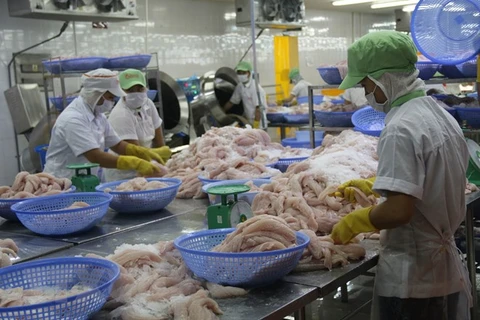Hanoi (VNA) – The Vietnam Export Promotion Forum 2018 was held in Hanoi on April 24 to seek solutions to boost the export of Vietnamese-branded products in a fast and sustainable manner.
Vu Ba Phu, Director of the Vietnam Trade Promotion Agency (VIETRADE) under the Ministry of Industry and Trade (MOIT), said the country’s export markets have been expanded with improved trade balance over the past years. There has been an increase in the overseas shipments of processed and manufactured products, along with a decline in the export of goods groups of natural resources and goods with low added value, he said.
In the context of deeper international economic integration, Vietnam has actively negotiated and signed many free trade agreements (FTAs), especially new-generation FTAs with major partners like the Republic of Korea, the European Union (EU), and the Eurasian Economic Union, Phu said.
To exist and develop, he said, Vietnamese businesses need to change their mindset and actively promote their production and business capacity in parallel with developing brand names and improving the quality of products and export value to meet consumers’ increasing demand.
Tran Thanh Hai, Deputy Director of the MOIT’s Import-Export Department, said total export revenue exceeded 200 billion USD for the first time in 2017, up 21.2 percent from a year earlier.
Hai said the recent export growth has considerably contributed to the country’s GDP growth, payment balance improvement and macro-economic stability, adding that exports in 2018 are forecast to continue the upward trend.
He said the MOIT encourages the export of some potential commodities, including textiles and garments which have posted a relatively rapid export growth rate. Businesses should step up exporting FOB (free-on-board), ODM (original design manufacturer) and OBM (original brand manufacturer) products instead of CMT (cut, make and trim) garments like they do at present so as to increase the value of export products and engage more in global production chains, the official suggested.
Hai also advised local companies to boost exports to niche markets to avoid direct competition with big rivals.
The footwear industry is also facing the same situation as the textile-garment industry when most of enterprises in this sector have just manufactured products to orders.
From January 2019, companies shipping footwear to the EU can certify their products’ origin by themselves, which is a good condition for stronger exports to this market and promises higher export turnover in the years ahead, Hai noted.
Le Hoang Oanh, Director of the MOIT’s Department of Asian and African Markets, said the ministry has enhanced bilateral and multilateral negotiations recently, but it is just the initial step helping to open markets.
What businesses need to do is capitalising on preferential treatment under FTAs, she said, stressing that local authorities should also help their enterprises to take part in trade fairs and improve product quality.-VNA
VNA

























